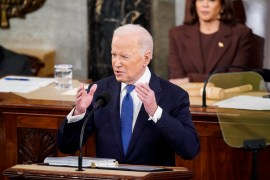By Elaine Kamarck
Like presidents before him, Joe Biden will almost certainly focus his State of the Union on his accomplishments and on good news. The lowest unemployment rate in 52 years? That will certainly make the list. Inflation coming down? You bet. The public health emergency ending in May? Finally. Manufacturing returning to the U.S. Passage of the CHIPS bill so that the US will not be vulnerable to shortages of computer chips or vulnerable to supply disruptions in the future. The Infrastructure Investment Act which will make the airports sleeker and the roads safer. The Inflation Reduction Act providing money to finally tackle climate change.
And yet Americans are in a really sour mood. An NBC poll asked voters whether America was on a right track or on a wrong track and found that in eight out of nine recent polls over 70% of voters declared America on the wrong track. The most recent poll found that 71% of Americans believe the nation is on the wrong track. The NBC News’ poll has never before recorded this level of sustained pessimism in the 30-year-plus history of the poll. This pessimistic mood is found in other polls as well. For instance, Pew found that 78% of Americans were dissatisfied with the direction of the country.
Why? There are, of course, many possible reasons. As Bill Galston and I have written before in these pages, inflation is a particularly tough political problem. Voters are reminded of it every day and the cure (recession) is usually worse than the disease. Decades of low trust in government makes citizens reluctant to believe that government spending can fix many problems. Though fading, the pandemic has left a trail of disruption in its wake. The spike in violent crime has left many citizens feeling unsafe in their own neighborhoods.
But there’s another possible explanation for the country’s negative mood. It goes like this:
America is changing and change makes people uncomfortable. Many Americans complain that they no longer recognize their country. Not all of them are white nationalists or racists; many are just uncomfortable with the changes they have seen in their lifetimes. America is no longer an overwhelmingly white, Christian nation.
At the beginning of the 20th century—1910—88.1% of U.S. citizens were white. Over the next seventy years that number dropped slowly to 79.6% (down 8.5%). But in the next forty years, from 1980 to 2020, the proportion of the population that is white dropped much more rapidly, by 20.8 percentage points. By the 2020 election only 58.8% of the population was white.
There is a distinct generational aspect to this drop. As my colleague and demographer William Frey writes:
“Most noteworthy is the increased diversity in the younger portion of the population. In 2019, for the first time, more than half of the nation’s population under age 16 identified as a racial or ethnic minority. Among this group, Latino or Hispanic and Black residents together comprise nearly 40% of the population. Given the greater projected growth of all nonwhite racial minority groups compared to whites—along with their younger age structure—the racial diversity of the nation that was already forecasted to flow upward from the younger to older age groups looks to be accelerating.”
The “browning” of America has important political and market consequences. While many in these minority groups are still mired in age-old cycles of poverty, prejudice, and powerlessness, others are coming of age and assuming leadership positions. We’ve had a black President and a black female vice president and a black, female Supreme Court Justice. Equally unnerving to many Americans is the appearance of more and more minorities in commercials. Ad-makers are not interested in political correctness. They are interested in building future market share for their product, whether it’s butter or cars. And the future is as brown as it is white.
Older Americans look at younger generations and don’t see themselves. And the younger generations look at many of the people in leadership positions and wonder why these old white guys are still in charge. No wonder that, in a country where things are going pretty well, the population is wallowing in pessimism, with members of each party convinced that the other is out to destroy the America they know. Non-white Americans are generally more optimistic and see the country on a better track than white Americans, yet both groups share a general pessimism towards the future.
There is no policy fix to this problem; it is fundamentally a problem of generations and of cultures. Politicians can try to soften the rough edges, as Biden will try to do, or exacerbate the fear of change, as Trump has done and continues to do. But until this cycle of change is complete two visions of America will coexist locked in pessimism.


